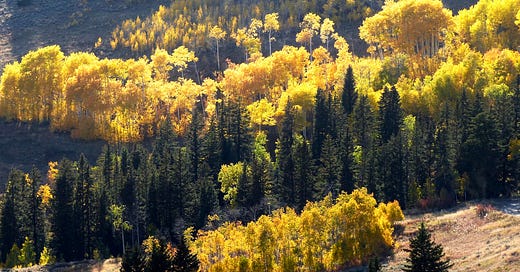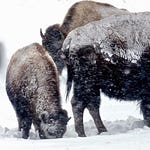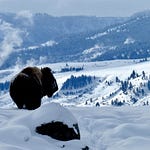In the early morning light of a crisp fall day not so long ago, Mary, Bob Beschta, and I hike toward the distant hills where the two of us will assist Beschta in his research. This Oregon State University professor emeritus, has observed firsthand since 2001 how aspens, cottonwoods, willows, and berry-producing shrubs have recovered since wolves returned to Yellowstone. This research has left no doubt in his mind about the beneficial ecological footprint of wolves.
Farther along the trail, Beschta points with a hiking pole to some healthy young aspens—what he calls recruits, They’re growing along Glen Creek. If wolves were absent from Yellowstone, he says, those aspens and nearby willows would be eaten down to the nubs by elk who could dine for as long as they pleased. But fearing wolves, or the threat of wolves, elk have changed where and how they eat. This has allowed plants that were once ravaged by elk to grow six feet tall. Reaching that height is critical for their survival.
As the aspens and willows have flourished along Glen Creek, beavers have settled nearby, since they too love to eat both plants. They’ve built a dam on the creek, and its pond reflects clouds and sky. This pond moistens and softens an expanding area of ground at its edges. Elk do not like feeding on such soft ground, possibly because it slows their escape from wolves. But aspens and willows love moist ground, and without elk browsing the plants to within an inch of their lives, the stand has grown taller and wider.
Leaving the trail, we bushwhack across the valley floor and rock-hop across Glen Creek to reach a stand of aspens and their recruits—thin saplings growing below a few mature trees. Beschta sets to work. He selects recruits and measures their height. He determines whether and when the recruit was browsed by elk. He relays this information to Mary, and she records the data in his field notebook.
After Beschta finishes measuring, he scans for conditions that could affect an elk’s decision on whether to dine here. Standing among the recruits, he turns a circle, points, and says to us, “If I’m an elk, I can see one hundred yards that way, one hundred yards this way. I can see approaching wolves. Even if they come out of the woods, I’ve got a good escape route.”
Where he stands, elk may have less reason to fear the presence of wolves and more reason to dine. That may explain why the recruits around him are so short. Another site could experience just the opposite if it has factors that make spotting wolves or escape difficult. There, elk could feel more fear and browse less. The aspens, willows, and cottonwoods could grow to that important six-foot height or even taller.
We bushwhack to a stand of six aspens higher up the hillside. Each of these trees is at least one hundred years old, Beschta says. Their trunks are thick and free of branches and leaves until halfway to the top. Standing below those trees, Beschta takes us on a journey through time.
First, we go back to 1900 when wolves roamed Yellowstone and kept the elk population in check. Back then we would be standing in the cool shade of a full aspen forest, thick with trees of all sizes, stair-stepping in height from sprouts to mature adults.
Moving forward to 1940, we would find the thick forest disappearing. Wolves are nowhere—the last one killed over a decade earlier. Hungry elk are everywhere. When adult aspens send up sprouts, elk chomp the tender recruits to within a couple feet of the ground. Year after year this scenario repeats until the ravaged sprouts die.
Next, we travel to the present where we find only aspen of two ages. First are the one-hundred-year-old survivors that tower above us. These trees sprouted before wolves were killed off. Second are their healthy recruits that have sprouted since wolves returned. Seven decades of aspens are missing in this stand. They were consumed by overabundant elk in the absence of wolves.
And if we zip one hundred years ahead, with wolves around to keep elk cautious and their population in check, this grove will look as it did in 1900—a full aspen forest with tiny sprouts to huge adults, with no sizes missing in between. All thanks to wolves.
Beschta suggests that perhaps we should call these trees “wolf aspen” because without the return of wolves, aspen would have disappeared from the landscape in this northern part of the park.
The sun is disappearing behind the Gallatin range when we bushwhack to the last stand of the day, a tall, single, old aspen, the limbs on one side leafless. It’s surrounded by hundreds of recruits. Some are ten feet tall. Beschta points to the ailing aspen and says that as the recruits grow, they take more water and nutrients from the soil. Deprived of nutrition, the sickly mother tree will die sooner than if there were no recruits growing below her. I’m touched by how this is similar to the way some human parents sacrifice for their offspring.
As we pack up and start the return trip to the trailhead, Beschta stops, looks around, smiles, and says, “It’s nice to be on a positive ecological story. I’ve been on so many downers. This one keeps bringing me back.”
I’m excited by all the young aspen we have walked among today, especially those over the magic six-foot height. I’m glad we have walked through a success story written by the ecological footprint of wolves.
Thanks for joining me in this Love the Wild! If you haven’t yet subscribed, I hope you’ll do so. It’s free and brings a Love the Wild letter to your inbox each week. In addition to stories inspired by photos, you’ll enjoy a variety of podcasts, photo essays, opinion pieces, excerpts from my books, and more. With each I hope to warm your heart and excite your mind as we share moments with wildlife and in wild lands.
I write, speak, and photograph to protect wildlife and preserve wild lands. My bestselling In the Temple of Wolves; its sequel, Deep into Yellowstone; and its prequel, The Wilds of Aging are available signed. My books are also available on Amazon unsigned or as eBook or audiobook.
Photo Credits: Photo by Rick Lamplugh











Share this post